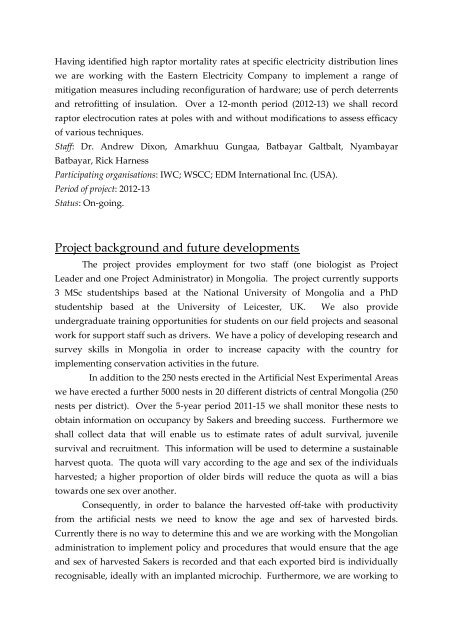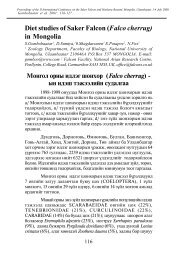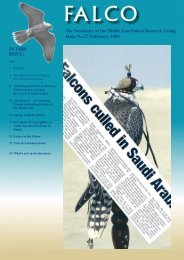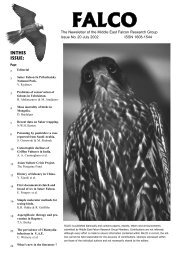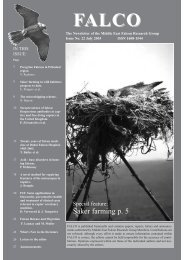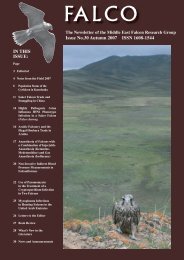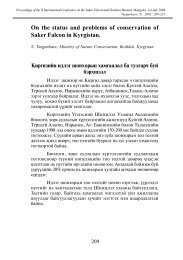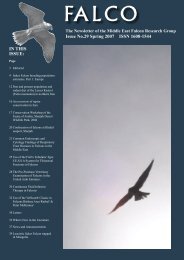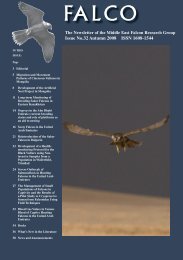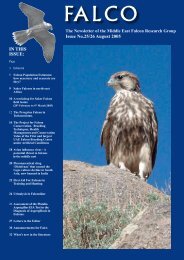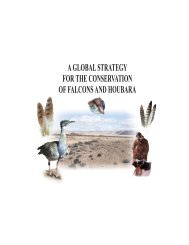Saker Falcon projects - International Wildlife Consultants Ltd.
Saker Falcon projects - International Wildlife Consultants Ltd.
Saker Falcon projects - International Wildlife Consultants Ltd.
Create successful ePaper yourself
Turn your PDF publications into a flip-book with our unique Google optimized e-Paper software.
Having identified high raptor mortality rates at specific electricity distribution lines<br />
we are working with the Eastern Electricity Company to implement a range of<br />
mitigation measures including reconfiguration of hardware; use of perch deterrents<br />
and retrofitting of insulation. Over a 12-month period (2012-13) we shall record<br />
raptor electrocution rates at poles with and without modifications to assess efficacy<br />
of various techniques.<br />
Staff: Dr. Andrew Dixon, Amarkhuu Gungaa, Batbayar Galtbalt, Nyambayar<br />
Batbayar, Rick Harness<br />
Participating organisations: IWC; WSCC; EDM <strong>International</strong> Inc. (USA).<br />
Period of project: 2012-13<br />
Status: On-going.<br />
Project background and future developments<br />
The project provides employment for two staff (one biologist as Project<br />
Leader and one Project Administrator) in Mongolia. The project currently supports<br />
3 MSc studentships based at the National University of Mongolia and a PhD<br />
studentship based at the University of Leicester, UK. We also provide<br />
undergraduate training opportunities for students on our field <strong>projects</strong> and seasonal<br />
work for support staff such as drivers. We have a policy of developing research and<br />
survey skills in Mongolia in order to increase capacity with the country for<br />
implementing conservation activities in the future.<br />
In addition to the 250 nests erected in the Artificial Nest Experimental Areas<br />
we have erected a further 5000 nests in 20 different districts of central Mongolia (250<br />
nests per district). Over the 5-year period 2011-15 we shall monitor these nests to<br />
obtain information on occupancy by <strong>Saker</strong>s and breeding success. Furthermore we<br />
shall collect data that will enable us to estimate rates of adult survival, juvenile<br />
survival and recruitment. This information will be used to determine a sustainable<br />
harvest quota. The quota will vary according to the age and sex of the individuals<br />
harvested; a higher proportion of older birds will reduce the quota as will a bias<br />
towards one sex over another.<br />
Consequently, in order to balance the harvested off-take with productivity<br />
from the artificial nests we need to know the age and sex of harvested birds.<br />
Currently there is no way to determine this and we are working with the Mongolian<br />
administration to implement policy and procedures that would ensure that the age<br />
and sex of harvested <strong>Saker</strong>s is recorded and that each exported bird is individually<br />
recognisable, ideally with an implanted microchip. Furthermore, we are working to


